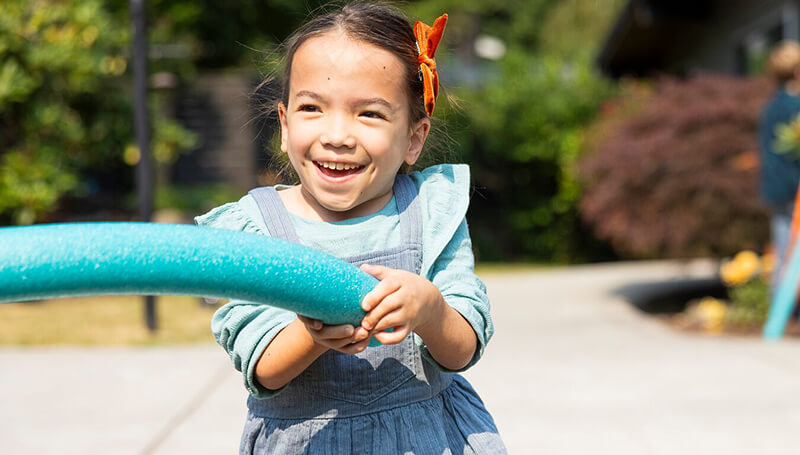Dental Health at Birth and Beyond: Hints for a Healthy Mouth
You can download this article as a PDF (English) (Spanish).
How should I clean my baby’s gums and teeth?

- Beginning at birth, wipe your baby’s gums daily with a clean, damp cloth.
- To make it easier to clean your baby’s mouth, place their head in your lap.
- Start brushing twice a day with a soft toothbrush when your baby’s teeth begin to come in.
- You can use a very small amount of toothpaste with fluoride when you brush. You only need an amount equal to a grain of rice for children under 3.
When should my baby’s teeth be checked?
- Have your baby’s mouth checked by their doctor or a dentist by age 1. Early care will help prevent dental disease and protect your child’s health.
- Check your baby’s teeth often yourself. Lift your child’s lip and look for white spots on the teeth or changes in the gums. Talk with your baby’s doctor or your own dentist if you notice any problems.
Can babies get cavities?
- Yes, baby teeth decay easily and they need care.
- Cavities are caused by germs. Food and drinks with sugar can help these germs grow.
- If your baby has their teeth (usually around 9 to 12 months) and takes a bottle to bed or at naptime, use water. Milk, formula and especially juice can lead to decay on your baby’s teeth.
- If you breast feed your baby beyond the age of 1, there may be more risk your baby will get cavities.
- Parents can pass germs to their baby by sharing cups, spoons, or tasting their child’s food. Parents should have good dental health and be sure to see a dentist at least once a year.
How do I keep my child’s teeth healthy as they get older?
- Baby teeth are just as important as adult teeth. They help your child speak and chew well. Most importantly, they hold space for adult teeth.
- Your child will begin losing baby teeth when they are about 5 or 6. Some of your child’s baby teeth will not fall out until they are about 12.
- Have your child brush their teeth two times each day. An adult should help your child brush one of these times. It’s best if the adult helps with the bedtime brushing. Your child can go first and then you can take a turn, making sure to get all of their teeth clean. Use a pea-size amount of toothpaste with fluoride for kids age 3 and older.
- Starting around age 3, floss between your child’s teeth that touch each other.
- The American Academy of Pediatric Dentistry recommends 2 dental checkups a year for most children. Your child’s dentist will discuss the best schedule for your child.
- Let your child’s dentist know if your child is over 3 and sucks their thumb or finger.
- Dental sealant is a thin, clear protective coating that a dentist can paint onto the chewing surface of back teeth. Sealants help keep teeth cavity-free. Ask your child’s dentist if sealants are a good option for your family.
- Fluoride treatments can help prevent tooth decay. Your child’s dentist may give your child fluoride treatments at checkups.
- Keep helping your child brush at night until they can tie their shoes well or write cursive. This is a good way to judge when they have the motor skills needed to brush well. Most children need help until age 6 or 7. Let your child practice brushing and spitting until then.
What can I do if my child does not like to have their teeth brushed or flossed?
- Some children have trouble standing still and holding their mouth open. Try brushing and flossing with your child’s head in your lap or have your child lie on a bed or sofa. Offer them a book to look at or toy to play with while they are lying down. Taking care of your baby’s teeth and gums early in their life can help them accept having their teeth and gums brushed and flossed daily with little fuss.
- Brushing and flossing do not have to happen in the bathroom. Find a place in your home that works best for all of you. \
- Keep your child occupied as you brush and floss. Give your child something to hold onto, have them brush your teeth as you brush theirs, sing a song, or let your child watch in the mirror.
- If your child is sensitive to toothpaste, try dipping the toothbrush into fluoride mouth rinse and brushing.
- Make brushing and flossing part of a daily routine. With a child that resists brushing, a daily routine is more important than the amount of time your child lets you brush their teeth.
How do foods and snacks affect my child’s teeth?
- Sweet and sticky foods like candy, cookies, raisins or fruit snacks stay in the mouth longer and can lead to cavities.
- To keep your child’s teeth healthy, offer foods that are low in sugar and high in vitamins and minerals. Try cheese, yogurt, nuts, seeds, popcorn, whole grain crackers, meats and raw vegetables. Note: Chunks of cheese and meat, nuts, seeds, popcorn and raw vegetables can cause choking. If giving these foods to children younger than 4, cut them into small pieces first.
- Serve fresh fruit instead of juice. If you offer juice, limit it to four ounces of 100% fruit juice per day. Offer water or milk from a cup as the drink of choice.
- Avoid sweets between meals. If you offer your child sweets, it is best to eat them as dessert after a main meal instead of throughout the day.
- Each time your child eats sweets, brush their teeth well afterward or have them drink water. This will help limit the effects of sweet foods.
Is there anything else I should remember?
- Yes! Remember that healthy teeth are important to your child’s overall health. Take care of your own teeth and help your child form good dental habits early.
To Learn More
- American Academy of Pediatric Dentistry: www.mychildrensteeth.org
- The Mighty Mouth Campaign: www.themightymouth.org
- Visit your library for children’s books about going to the dentist.
- Your child’s healthcare provider

